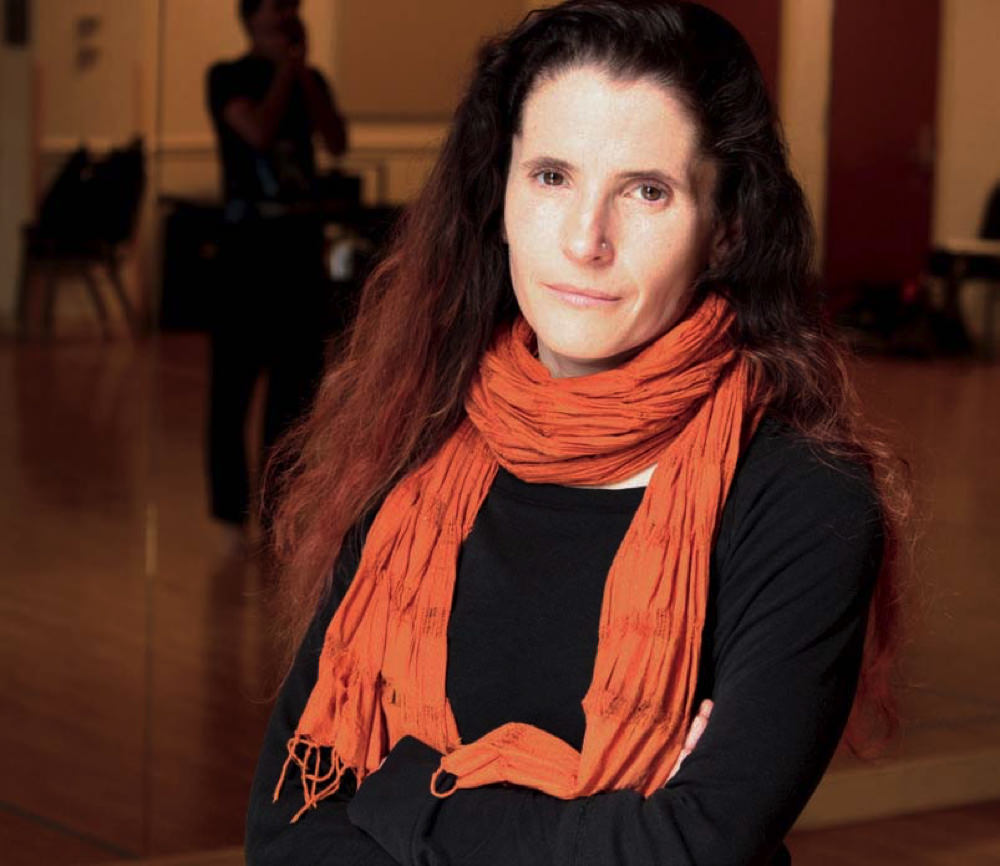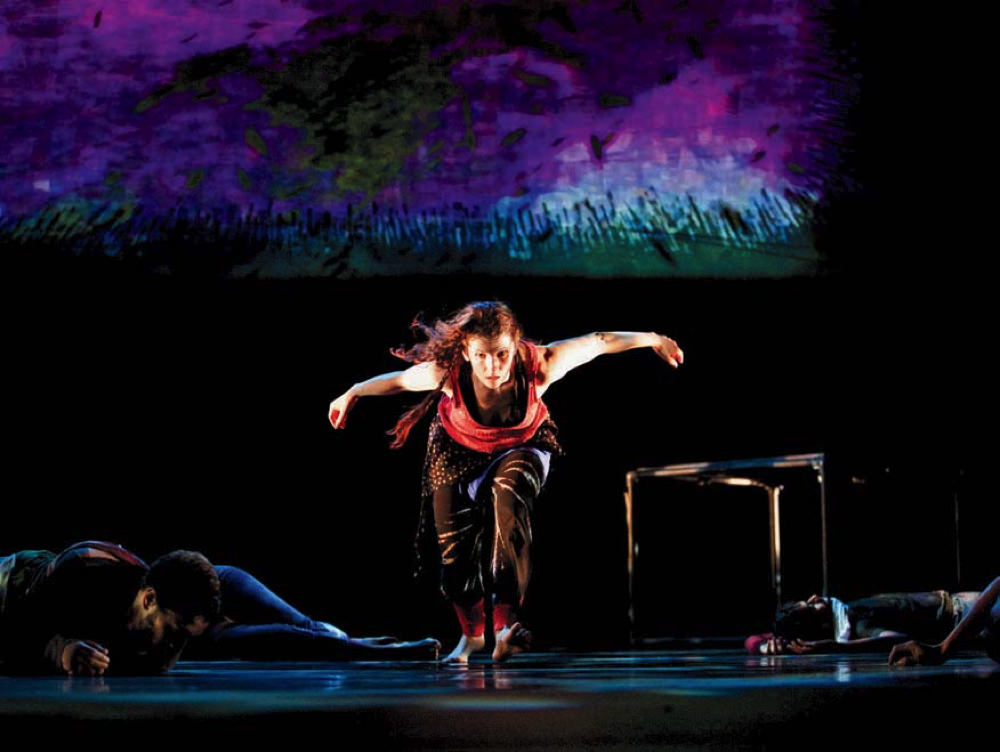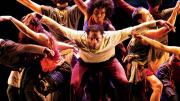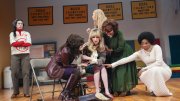When Wendy Jehlen, M.T.S. ’00, improvises dance, bharatanatyam comes out. The choreographer and dancer was trained in the South Indian classical genre from age seven or eight; while she didn’t become a bharatanatyam performer, its dizzying footwork and winding gestures are unmistakable in her work, a part of how her body naturally moves.
Her most recent production, The Conference of the Birds, based on the twelfth-century Persian Sufi poem of the same name, might at first bewilder viewers. Combining movement from South Indian dance, Brazilian capoeira, and a long list of other sources, the piece doesn’t represent contemporary dance as most people know it, or a mere fusion of styles. Instead it reflects the philosophy of Jehlen’s Boston-based dance company, ANIKAYA, which seeks to remove what she calls the “imagined barriers” between people, culture, and art around the world. “Imagined” is the key word for Jehlen. “I hate the idea of crossing borders, because they’re nonexistent. I can’t really understand the idea that cultures are separate or that they are monoliths,” she says. “It’s visibly not true.”

Wendy Jehlen
Photograph by Marcel Gbeffa
In some ways, The Conference of the Birds, which is all about people’s inseparability and interdependence, has been a lifelong endeavor. Jehlen grew up in a half-Jewish family in Somerville, Massachusetts, where it always felt natural and right to see immigrants from across the world who looked different from one another and spoke different languages and understood the world differently—for her, culture was a continuous process of mixing and reconstituting. Her aunt was a bharatanatyam dancer, and watching her perform, Jehlen recalls, was like a “religious experience.” Jehlen went to Brown to study something “very Brown,” she says, a self-directed major called “Storytelling and Survival: Ritual and Performance as Guardians of Culture.” After taking time off to dance in India, she enrolled at Harvard Divinity School in 1997 to learn Persian and study Sufi literature (and to access Harvard’s dance studios). She founded ANIKAYA—a blend of the Hebrew an (gift), the Persian i (of), and the Sanskrit kaya (body)—around the same time, as a vehicle for her various dance projects.
Jehlen says she always knew she was born to dance, and her career has combined the styles she learned growing up with genres from Japan, West Africa, and those of the many dancers she has traveled around the world to recruit. She calls the work “dance diplomacy”—but resists the concept of “fusion,” as though it were a process of randomly gluing together elements from different genres. “It’s important to me to learn something so thoroughly that it becomes part of your body,” she explains: to understand how each dance form uses the body, the deep relationships and symbols and meanings behind every movement and gesture. Humans are wired to be moved by dance, she says, but that doesn’t mean dance is a “universal language.” When Jehlen creates choreography with her partners, she emphasizes, “It’s not about the superficial aspect of the art form. We’re meeting at the core of the art form, not at the, ‘How do you move your hands?’”
The evening-length Conference of the Birds begins with its eight dancers (each from a different country) moving across the stage in full-bodied, synchronized flight, their arms evoking something between avian and human—as powerful and light as a bird’s wings. In the background, projections fill a screen with sketches of birds, text, and pieces of passports and visas, representing the violence of borders. The poem on which the show is based, by Farid ud-Din Attar, tells a spiritual, searching story about the birds of the world on a perilous quest to find their sovereign, Simorgh. In the end, the birds discover that they themselves, together, are the Simorgh; a Persian folk etymology translates the word to “30 (si) birds (morgh).”
“It’s actually based on a Sanskrit text, which is probably based on something even older,” Jehlen says. “This is a story that’s been with humanity for thousands of years: these questions of traveling, traveling together, traveling across, and of the necessity of all of our stories.” (The production premiered in Boston last year, and a weekend of performances in Washington, D.C., is planned for November. Jehlen is seeking funding to tour it around the country and the world. Grant-writing, she acknowledges, is a punishing endeavor of its own: sometimes “as time-intensive as creating art.”)
Some artists can think back to the moment they knew that music or dance or poetry was what they were meant to do. Jehlen resists origin stories. “I have no idea why things happen,” she insists. “I think it was probably my aunt,” she offers. “I really don’t know.” She’s reluctant to provide an explanation for her pursuits, perhaps partly because she doesn’t view her work as marked by any particular interest in a specific tradition—bharatanatyam or Sufi mysticism or the Japanese dance-theater form butoh—but instead by the larger, mysterious, interconnected human experience. ANIKAYA has also produced works inspired by the Hebrew Bible; the concept of gender; and the idea, common to world religions and modern physics, of a time before creation. “To me, physics is as awesome and fascinating as anything else,” she says. “I live for awe, and that’s very strong in the parts of Islam that I’m interested in. I live for cognitive dissonance and things that force you to wrap your head around other things.”

Jehlen as a starling in the “valley of bewilderment,” one of seven the birds must pass through on their search for Simorgh in The Conference of the Birds
Photograph by Gary Alpert
For Jehlen, it’s important that performances convey a specific emotional experience to viewers. Contemporary dance, she says, often focuses more on self-expression or exploring movement itself, and less on content. “My work is very much about content....We want viewers to understand it in the way we intend.” Next year, she hopes to tour with Sholeh Wolpé, the Iranian-American poet and playwright who translated the most recent English version of The Conference of the Birds. Wolpé would read a condensed version of the story before the performance, to give viewers a frame for understanding the dance.
“I think our work as artists is to train people to be empathetic,” Jehlen adds. Though she doesn’t often address it directly, she also thinks about the connection between her work and current culture and politics. “People get so much more attached to their identity when they perceive themselves as under attack. It can be a dangerous situation culturally because it makes you want to freeze your culture and label everything and separate everything.” But as Jehlen knows, the intersections of culture can be every bit as magical, and generative, as their core.









